Ottoman countercoup of 1909
The Ottoman countercoup of 1909 (13 April 1909) was an attempt to dismantle the Second Constitutional Era of the Ottoman Empire and replace it with an autocracy under Sultan and Caliph Abdul Hamid II. Unfortunately for the advocates of the representative parliamentary government, mutinous demonstrations by disenfranchised regimental officers broke out, which led to the collapse of the Ottoman government. Characterized as a countercoup, chaos reigned briefly and several people were killed in the confusion. It was instigated by some parts of the Ottoman Army in a large part by a Cypriot Islamist[1] Dervish Vahdeti, who reigned supreme in Constantinople (today known in English as Istanbul) for 11 days. The Countercoup was put down in the 31 March Incident, on 24 April 1909 by the Army of Action (Hareket Ordusu) which was the 11th Salonika Reserve Infantry Division of to the Third Army (Ottoman Empire) commanded by Mahmud Shevket Pasha.
Part of a series on the |
|---|
| History of the Ottoman Empire |
 |
| Timeline |
|
Rise (1299–1453)
|
|
Classical Age (1453–1566)
|
|
Transformation (1566–1703)
|
|
Old Regime (1703–1789)
|
|
Decline & Modernization (1789–1908)
|
|
Dissolution (1908–1922)
|
| Historiography (Ghaza, Decline) |
Name
The coup was an attempt to undermine the Young Turk Revolution of 1908, which was a coup, so it became known as the countercoup of 1909.
The suppression of the counterrevolution is known in Turkish as 31 Mart Vakası (31 March incident), due to date originating from the old Rumi calendar.[2]
Events
Prelude
The Young Turk Revolution, instigated by members of the Committee of Union and Progress (CUP) in the Balkan provinces, spread quickly throughout the empire and resulted in the Sultan Abdulhamid II announcing the restoration of the Ottoman constitution of 1876 on 3 July 1908. The 1908 Ottoman general election took place during November and December 1908. The Senate of the Ottoman Empire reconvened for the first time in over 30 years on 17 December 1908 with the surviving members from the first constitutional area. The Chamber of Deputies' first session was on 30 January 1909.
For the first 10 months in power the CUP cautiously undertook to establish its control and remove the sultan as a threat.[3] In the ensuring constitutional struggle and power shift by early August 1908 the CUP managed to get the grand vizier to appoint ministers for the navy and army instead of Abdul Hamid II.[3] Palace staff to the sultan was reduced and replaced with loyal CUP members who monitored the official correspondence of Abdul Hamid II.[3] During October, several Imperial Guard units were sent to the Hijaz and Yemen resulting in a small mutiny which was put down by the government that purged some officers while replacing them with mektepli officers.[3] By March 1909 two loyal Imperial Guard battalions consisting of Albanian units were sent to Monastir (modern Bitola).[4] With the CUP gradually removing the sultan's power, these events resulted in him becoming a figurehead.[4]
The Sultan maintained his symbolic position and in March 1909 attempted to seize power once more by stirring up populist sentiment throughout the Empire. The Sultan's bid for a return to power gained traction when he promised to restore the caliphate, eliminate secular policies, and restore the sharia-based legal system. The 1908 parliament lacked coherence, most of all on the nature and unity of the organization of the Empire. While the Young Turk Revolution had promised organizational improvement, once instituted, the government at first proved itself rather disorganized and ineffectual.
Counterrevolution
Opposition grew toward the CUP as groups and individuals competed for power in the provinces and the capital.[4] One week prior to the event, the CUP brought new battalions of soldiers from Macedonia to the Taşkısla barracks to replace Albanian and Arab troops that were perceived by the Young Turks as unreliable.[5] On 12 April the CUP declared that they no longer were a secret association and instead had become a political party.[6] During the night an uprising by armed and reactionary forces broke out that transformed into a mutiny by soldiers from the Macedonian battalions, most of whom were Albanians stationed in Constantinople (today, Istanbul).[6][7][5] The mutineering troops took their officers prisoner and one of the ringleaders was an Albanian non-commissioned officer named Hamdi Çavush.[7][5] A religious fundamentalist organisation Mohammedan Union were also involved in the mutiny.[6] On 13 April 1909 Army units revolted and were joined by masses of theological students (softas), turbaned clerics shouting, "The Sheriat is in danger, we want the Sheriat" along with other elements of the population and troops in Constantinople.[6][4][8]
From day one the leadership of the Liberals (Ahrar) attempted unsuccessfully to get control over events and stop the rebellion from turning toward a reactionary pro-Hamidian and anti-constitutional course.[9] Within the ranks of the Muslim clergy, those holding high positions among the ulema were against imams (hocas) that gave support to the uprising.[9] High ranking ulema did not give support to the rebellion as they were united within the Society of the Islamic Scholarly Profession (Cemiyet-i İlmiye-i İslamiye) and publicly denounced the revolt from 16 April onward.[9]
Throughout a twenty four-hour period the rebels took over Constantinople without much resistance from the army, government or CUP.[2] The crowd went to Hagia Sophia square making demands for the implementation of Sharia Law and moves toward restoring the Sultan's absolute power.[6][4] The government was in a state of chaos and did not send its loyal troops to deal with the revolt.[5] To deal with the situation the Chief of Police was sent instead to hear the requests of the crowds.[5] Six demands were prepared by the spokesmen of the mutineering soldiers: the return of Sharia law, banishment of some CUP parliamentarians from Constantinople, replacement of Ahmed Rıza the CUP President of the Chamber of Deputies, replacement of some CUP officers, the removal of the Grand Vizier along with the Ministers of War and Navy.[5] Grand vizier Hüseyin Hilmi Pasha was unable to appease the protestors and on 14 April during the afternoon he resigned his post at the palace with the sultan accepting his decision.[4][5] The sultan replaced him with Tevfik Pasha (Okday) as Grand Vizier as he was more in tune with the Hamidian regime.[4][5] Marshal Ethem Pasha, the War Minister of the new cabinet went to see the troops at Meydanı, gave them praise and told them that their requests would be fulfilled.[5] The victory was celebrated by the soldiers and religious students.[5] During the revolt, the CUP was targeted in a pogrom with protestors killing 20 people, mainly army officers, and two parliamentarians mistaken for Ahmet Rıza and Hüseyn Cahit (Yalçin), the editor of the CUP newspaper Tanin.[4][5] Protestors also burned a few CUP offices such as those belonging to Tanin.[4][5]
CUP members either hid or fled Constantinople.[10] As such the Chamber of Deputies with a CUP majority lacked the numbers for a parliamentary session.[5] Ismail Qemali, a Liberal deputy managed to get some parliamentarians to attend, they accepted the requests of the troops and made an official announcement that the constitution and Sharia law would be kept.[5] Uninvolved in the events of the initial countercoup Qemali was briefly made President of the Ottoman National Assembly and led it to recognise a new government by Abdul Hamid II.[11][7] Qemali wired his constituency in Vlorë telling them to acknowledge the new government and Albanians from his hometown backed him with some raiding the arms depot to support the sultan with weapons if the situation called for it.[7] At the same time Albanian clubs telegraphed support for quelling the uprising while Prenk Bib Doda, leader of the Mirdita offered assistance from his tribe, and these sentiments where more due to fears that the Hamidian regime could return than loyalty toward the CUP.[7] During the countercoup, Isa Boletini along with several Kosovo Albanian chieftains offered the sultan military assistance.[7]
The Sultan in turn promised to bring about the rule of religion, were he to be returned to power. The leader Dervish Vahdeti reigned supreme in Constantinople for 11 days.
One of the causes of the countercoup were that several different groups were disenchanted with the changes that had come about. These included those who enjoyed patronage jobs under Abdul Hamid and had been discharged, army officers who had risen from the ranks and were no longer being favored over officers who had been to military school, and the religious scholars (ulema) who felt threatened by the more secular atmosphere and new constitution that gave equal rights to all citizens irrespective of religion.[12] Some writers have accused the British, led by Sir Gerald Fitzmaurice (1865–1939), Chief Dragoman of the British Embassy, of being the hidden hand behind this reactionary religious uprising. The British government had already supported actions against constitutionalists in an attempt to mute the effect of increasing German sympathizers in the Ottoman Empire since the 1880s.[13] Also, according to these sources, this countercoup was directed specifically against the CUP's Salonica (Thessaloniki) branch, which had outmatched the British-sympathizing Monastir (Bitola) Branch.
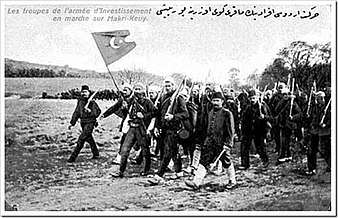 Army of Action marching on Makri Keuy (modern Bakırköy)
Army of Action marching on Makri Keuy (modern Bakırköy)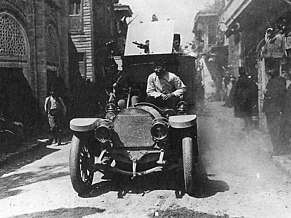 Taksim Military Barracks, where the counter-coup commenced
Taksim Military Barracks, where the counter-coup commenced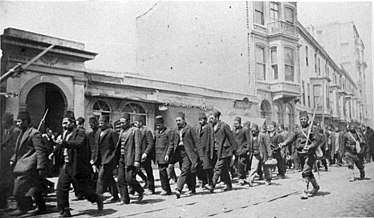 Counterrevolutionary prisoners of the 31 March Incident
Counterrevolutionary prisoners of the 31 March Incident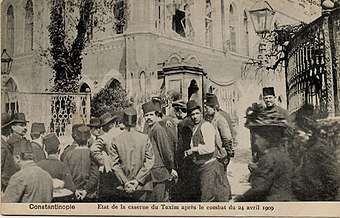 Young Turk revolutionaries entering Constantinople in 1909
Young Turk revolutionaries entering Constantinople in 1909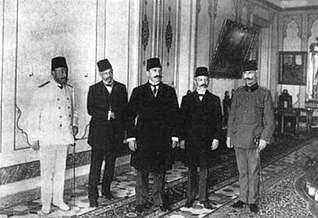 Delegation to Abdul Hamid II informing him of his dethronement. Esad Pasha Toptani is the figure in centre
Delegation to Abdul Hamid II informing him of his dethronement. Esad Pasha Toptani is the figure in centre
The CUP retained its position among the provinces, especially in Macedonia and it began to perform immediate countermeasures.[14] Public demonstrations were organised at towns in the provinces while numerous telegrams were sent to the palace and parliament.[9] The propaganda battle was won by the CUP in Macedonia as people became convinced that the constitution was in peril.[9] Beginning from 15 April the CUP organised a military operation to go after the rebels.[9] The CUP appealed to Mahmud Shevket Pasha, commander of the Ottoman Third Army based in Salonika to quell the uprising.[4][9] With support from the commander of the Ottoman Second Army in Adrianople (now, in Turkish at the time, known as Edirne), Mahmud Shevket combined the armies to create a strike force named Hareket Ordusu ("Army of Action").[4][9] The Army of Action numbered 20,000-25,000 Ottoman troops[4] and were involved in events known as the 31 March Incident toward ending the coup.[14] The eleventh Reserve (Redif) Division based in Selanik composed the advance guard of the Action Army and the chief of staff was Mustafa Kemal (Atatürk).[9]
The Action Army were joined by 15,000 volunteers including 4,000 Bulgarians, 2,000 Greeks and 700 Jews.[4] Adding to those numbers were Albanians that supported the Action Army with Çerçiz Topulli and Bajram Curri bringing 8,000 men and Major Ahmed Niyazi Bey with 1,800 men from Resne.[15] In short time CUP members Fethi Okyar, Hafız Hakkı and Enver Bey returned from their international posts at Ottoman embassies and joined Mahmud Shevket as his military staff prior to reaching Constantinople.[16][9] Traveling by train the soldiers went to Çatalca, then Hademköy and later reached San Stefano or Ayastefanos (modern Yeşilköy) located on the edge of Constantinople.[9] A delegation was sent to Army headquarters by the Ottoman parliament that sought to stop it from taking Constantinople through force.[9] The response was negative and the delegation then went to Ayastefanos and made a call for colleagues to unite with them.[9] Both parliamentary chambers convened as a National Assembly (meclis-i umumi-i milli) at the Yachting Club building of Ayastefanos on 23 April and thereafter.[9] Qemali had left the city prior to the Action Army arriving at Constantinople and he fled to Greece.[17]
On 24 April the occupation of Constantinople by the Action Army began in the early morning through military operations directed by Ali Pasha Kolonja, an Albanian, that retook the city with little resistance from the mutineers.[18][19] The barracks of Tașkışla and Taksim offered strong resistance and by four o'clock of the afternoon the remaining rebels surrendered.[19] Under martial law and following the defeat of the rebellion two courts martial sentenced and executed the majority of the rebels which included Dervish Vahdeti.[19] Albanians involved in the counterrevolutionary movement were executed such as Halil Bey from Krajë which caused indignation among conservative Muslims of Shkodër.[18] Some Liberal (Ahrar) political leaders were arrested and British pressure resulted in their freedom.[19] A government investigation later cleared Qemali of any wrongdoing.[7]
Aftermath
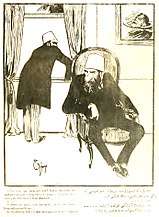
The consequences was the restoration of the constitution (for the third time; 1876, 1908 and 1909). Both parliamentary chambers convened together on 27 April and deposed Abdul Hamid II.[18][4][19] He was replaced with his younger brother Reşat who took the name Mehmed V, to symbolically convey him as the second conquer of Constantinople after Mehmed II.[18][4][19] Four CUP members composed of one Armenian, one Jew and two Muslim Albanians went to inform the sultan of his dethronement, with Essad Pasha Toptani being the main messenger saying "the nation has deposed you".[4] Some Muslims expressed dismay that non-Muslims had informed the sultan of his deposition.[4] As a result, the focus of the sultan's rage was toward Toptani whom Abdul Hamid II felt had betrayed him.[4] The sultan referred to him as a "wicked man", given that the extended Toptani family had benefited from royal patronage in gaining privileges and key positions in the Ottoman government.[4]
The uprising done in the name of Islam had managed to distablise the Young Turk regime in a short period of time and it came as a shock to the CUP.[2] The legacy of the counterrevolution following the establishment of the secular Turkish Republic continued as a memory and trauma among Kemalists, due to most of them having been CUP members in the Ottoman era.[2] In Turkey for people supporting secularism the counterrevolution became a reminder of the threat of Muslim fundamentalism.[2] In Turkey when the secular system of government appears to be in danger, references toward the March thirty first event are often made.[2]
References
- Muammer Kaylan. The Kemalists: Islamic Revival and the Fate of Secular Turkey. Prometheus Books, Publishers. p. 74. ISBN 978-1-61592-897-2.
- Zürcher 2017b, p. 200.
- Gawrych 2006, p. 166.
- Gawrych 2006, p. 167.
- Zürcher 2017b, p. 201.
- Skendi 1967, pp. 363–364.
- Gawrych 2006, p. 168.
- Zürcher 2017b, pp. 200–201.
- Zürcher 2017b, p. 202.
- Zürcher 2017b, pp. 200–202.
- Skendi 1967, p. 364.
- Erik J. Zurcher (2003). Turkey: A Modern History. I.B. Tauris & Co.. pp. 102-103.
- G R Berridge,"Gerald Fitzmaurice (1865-1939) Chief Dragoman of the British Embassy in Turkey" Published by Martinus Nijhoff
- Zürcher 2017b, pp. 200, 202.
- Gawrych 2006, pp. 167–168.
- Yılmaz, Șuhnaz (2016). "Revisiting Netwrosk and Narratives: Enver Pasha's Pan-Islamic and Pan-Turkic Quest". In Moreau, Odile; Schaar, Stuart (eds.). Subversives and Mavericks in the Muslim Mediterranean: A Subaltern History. University of Texas Press. p. 144. ISBN 9781477310939.CS1 maint: ref=harv (link)
- Gawrych, George (2006). The Crescent and the Eagle: Ottoman rule, Islam and the Albanians, 1874–1913. London: IB Tauris. p. 179. ISBN 9781845112875.CS1 maint: ref=harv (link)
- Skendi, Stavro (1967). The Albanian National Awakening. Princeton: Princeton University Press. pp. 364–365. ISBN 9781400847761.CS1 maint: ref=harv (link)
- Zürcher, Erik Jan (2017b). "31 Mart: A Fundamentalist Uprising in Istanbul in April 1909?". In Lévy-Aksu, Noémi; Georgeon, François (eds.). The Young Turk Revolution and the Ottoman Empire: The Aftermath of 1918. I.B.Tauris. p. 203. ISBN 9781786720214.CS1 maint: ref=harv (link)